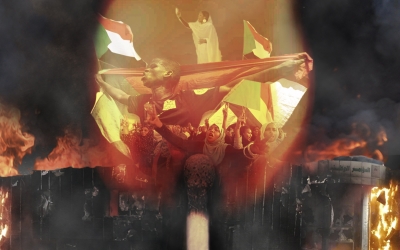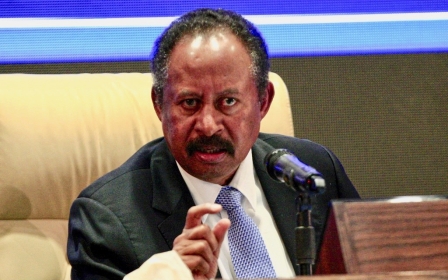'He is our leader': Sudan's PM warmly received in rebel-held south

A decision by Sudan's prime minister to visit the rebel bastion of Kauda was warmly received by locals, as it marked the first time a senior official from Khartoum travelled to the area since clashes erupted more than eight years ago.
Kauda, about 90km east of South Kordofan state's capital Kadugli, has been the base of the Sudan People's Liberation Movement North (SPLM-N), the main group fighting the government in the southern provinces of Blue Nile and South Kordofan.
'We now feel that that the prime minister is a leader for all of us,'
- Abdul Azim Kafy, Kauda resident
Addressing a rally in Kauda on Thursday, Prime Minister Abdalla Hamdok pledged to establish peace in the country, adding that people in the Nuba Mountains had suffered long enough.
"Peace is a priority and will not be ignored," he told crowds of supporters.
"The Sudanese people have suffered and this revolution will not be complete unless we realise the injustice of those who were targeted ... my visit to Kauda is an important step to admit it."
New MEE newsletter: Jerusalem Dispatch
Sign up to get the latest insights and analysis on Israel-Palestine, alongside Turkey Unpacked and other MEE newsletters
Hamdok's visit comes weeks after a request from the SPLM-N head, Abdul Aziz Alhilu, that the country adopt secularism following the ouster of former president Omar al-Bashir, or grant self-determination to Christians who mainly live in the Nuba Mountains.
Bashir, who was overthrown by the country's military last April last, had repeatedly vowed to "pray" in Kauda since the rebels picked up arms against the government, following South Sudan's independence in 2011.
Since his downfall, an 11-member sovereign council led by Hamdok has vowed to establish peace in conflict-hit regions, including Blue Nile, South Kordofan and Darfur.
Who are Sudan's rebel groups?
+ Show - HideSRF: Sudanese Revolutionary Front
Rebel groups fighting in Darfur, Blue Nile State and South Kordofan formed the SRF in 2011 to unite efforts in talks with the government and have advocated for greater representation for minorities and marginalised communities during Sudan's post-Bashir transition
SPLM: Sudan People's Liberation Movement
Founded by the iconic rebel leader John Garang, who aimed for a democratic Sudan, the SPLM fought a war against the Sudanese state that eventually led to the secession of South Sudan in 2011. It is now South Sudan's ruling party, led by President Salva Kiir.
SPLM/N: Sudan People's Liberation Movement - North (Agar faction)
Garang's allies formed a northern branch of the SPLM after South Sudan's independence to focus on establishing the SPLM's vision of equality in Sudan. In 2011, SPLM-N chairman Malik Agar was removed by Bashir from his elected position as governor Blue Nile state and launched a rebellion that saw him take control of part of the region.
SPLM/N (Alhilu faction)
The group's vice-chair Abdel Aziz Alhilu splintered to create a faction focused on the grievances of South Kordofan, which borders South Sudan, and has become the most influential Sudanese rebel faction, fighting from the Nuba mountains and controlling large amounts of territory.
SLA/AW: Sudan Liberation Army - Abdul Wahid faction
In 2001 leaders from different indigenous Darfuri communities formed the Sudan Liberation Army to fight Bashir's government, claiming they represented Sudan's marginalised communities. The government was accused of carrying out genocide in its response, which used militias known as the Janjaweed to attack Darfuri communities.
Ethnic Fur, Khartoum-educated lawyer Abdul Wahid was the original chairman and now leads his own faction after the group splintered. Since 2016, Sudanese forces have been trying to clear SLA-AW fighters from the Jebel Marra area of Darfur.
SLA/MM: Sudan Liberation Army - Minni Minnawi faction
SLA commander Minni Minnawi, from the Zaghawa herder community, split from Abdul Wahid and formed his own faction. They have had very little presence in Darfur in recent years, basing themselves in neighbouring Libya.
JEM: Justice and Equality Movement
Founded based on grievances about inequality of power in Sudan and with more religious affiliation than other rebel groups, including leaders who were former members of the Islamist movement, JEM eventually became the most powerful Darfuri group. In 2008 it attempted to overthrow the government by storming Khartoum, only halted when they clashed with Sudanese forces in the capital's sister city Omdurman.
Alhilu praised Hamdok's visit, adding that the rebels were open to "work with the transitional government".
"This visit comes at an important time and we confirm our openness to work with the transitional government to achieve sustainable peace in our country," Alhilu said.
"There is no way to achieve peace unless we recognise the crimes that were committed against marginalised people and set up new system and social contract that guarantees equality and an end to exclusion."
The SPLM-N was born out of the SPLM, which led a war against Sudan's government from 1983 to 2005.
Since it it succeeded in gaining independence from Sudan in 2011, South Sudan, the world's youngest country, has been gripped by its own civil war in which hundreds of thousands of people are believed to have been killed.
Hamdok's visit was also widely praised by the international community and was accompanied by a host of foreign envoys, including the US special envoy to Sudan, the ambassador of the European Union to Sudan and UN representatives.
"This is the first time since 2011 that the Sudanese government was able to travel peacefully from Khartoum directly to territory held by the country’s largest armed opposition group," representatives of the United States, Norway and the United Kingdom said in a joint statement.
'The PM is a leader for all of us'
Abdul Azim Kafy, a 45-year-old from Kauda, said Hamdok's visit may usher in an era of peace and justice in the volatile region.
"This visit has delivered many positive messages to the people of Kauda that we are Sudanese people. This is a feeling we have never witnessed before.
"We now feel that that the prime minister is a leader for all of us."
Mashair Atim, 35, told MEE that the transitional government should move quickly to address the suffering of the local population.
"We want to see peace become a reality," Atim said.
"We are confident that Hamdok is different from the old regime of Bashir that sent Antonov bombers to kill us and used food as a weapon against us," she added.
Sudan's army is believed to have used Russian military planes during its bombing raids on the region in 2011 that led to the deaths of hundreds of civilians.
Ammar Awad, a Sudanese political analyst, also described the visit as an historic one that may yield a breakthrough between the transitional government and one of the strongest rebel movements.
"The visit will build confidence between the rebels and those affected by the war with the prime minister, and also provide a real chance for more talks on outstanding issues."
Hamdok's visit also coincided with the restart of humanitarian access to the region after almost a decade of it being blocked by the government.
"Since 2011 humanitarian assistance has been absent, and we are fully aware of the importance of continuing assistance to those in need," Hamdok said.
Middle East Eye delivers independent and unrivalled coverage and analysis of the Middle East, North Africa and beyond. To learn more about republishing this content and the associated fees, please fill out this form. More about MEE can be found here.






